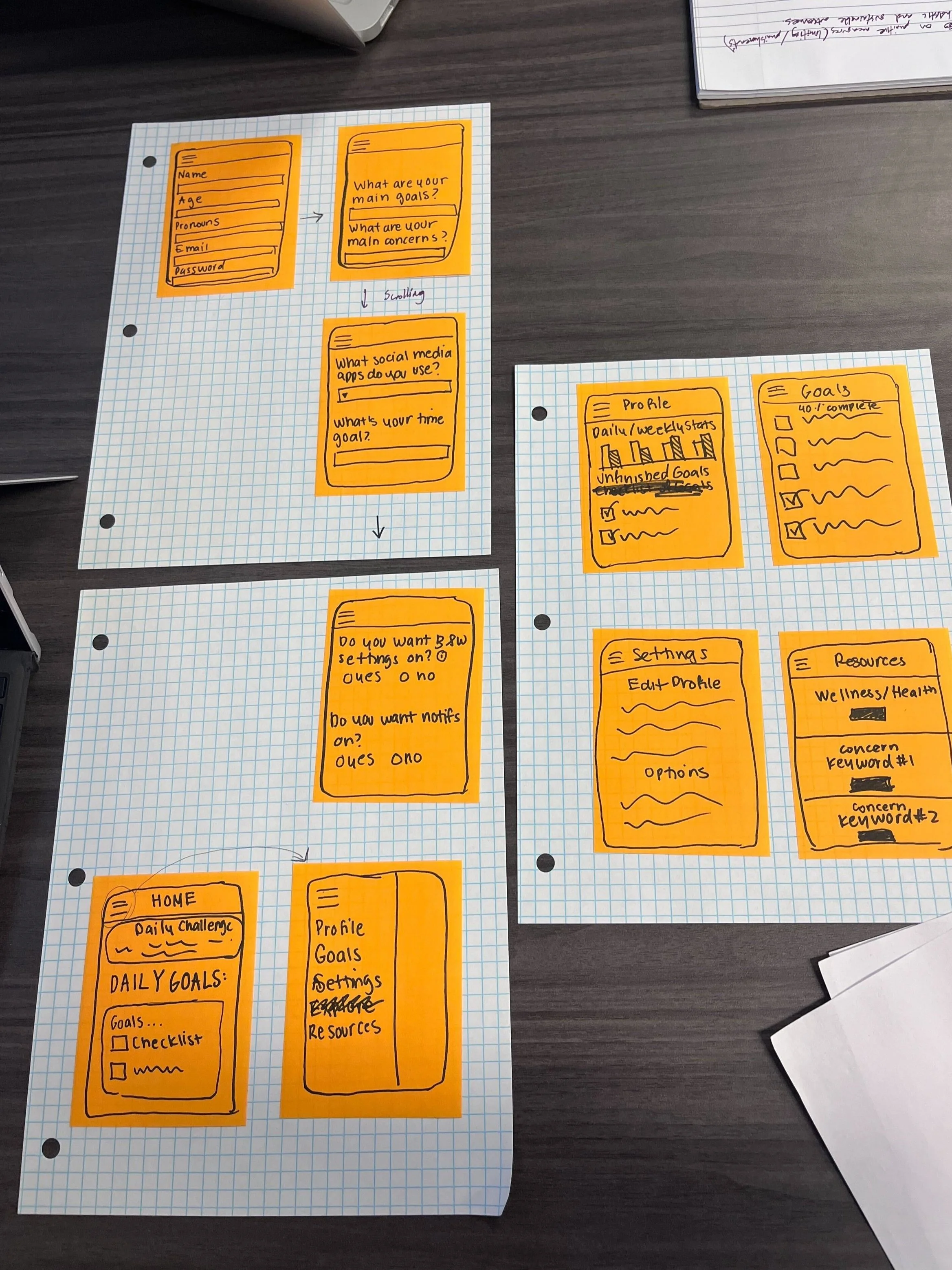MindfulTech
A Mobile application For digital thriving in young adults
Project Brief
In the fall of 2022, OpenIDEO hosted a design challenge on digital thriving, with co-sponsors including Riot Games, FairPlay Alliance, Sesame Workshop, and IDEO. This project was created in my “Project in Human-Computer Interaction Requirements and Evaluation” Informatics course, at the University of California Irvine. The course was led by Dr. Layne Jackson Hubbard, who used OpenIDEO's design challenge question as our inspiration for UX research & design:
How might we design healthy, inclusive digital spaces that enable individuals and communities to thrive?
Contextual analysis
Young adults today spend increasing amounts of time on social media, negatively impacting their mental health. To address this issue, stakeholders in the mental health community and the technology industry collaborate to create a healthier online environment for users. Our application will have a positive impact on young adults and social media influencers by promoting better mental health and reducing social media addiction. It will also benefit indirect stakeholders such as parents, mental health professionals, and educators by reducing adverse effects associated with excessive social media use, such as peer pressure, burnout, decreased academic performance, and cyberbullying.
Our Vision for Impact
We are currently coming up with a prototype to design a solution to prevent social media addiction in college undergraduates who have addictive behaviors. Typically college students or essentially anyone with mental illness might face a symptom called addictive behavior, where they become addicted to things easily. Social media doesn’t make this easy since most social media companies in fact design their applications for mindless infinite scrolling to maximize their profits without keeping their ethics in mind. After careful thought, we formed our own design question to supplement OpenIDEO’s; How Might We Prevent Social Media Addiction to Build Mental Wellness in Young Adults?
Primary & Secondary Research
Social media use can contribute to social media addiction, particularly for those with low senses of autonomy and competence. Additionally, heavy smartphone use and media multitasking can lead to chronic sleep deprivation, which can result in negative effects on academic and socioemotional functioning. Clinicians can collaborate with youth and their families to reduce potential harm through education and practical problem-solving. Additionally, public awareness campaigns and social policy initiatives are necessary to promote nurturing environments that foster resilience among youth.Individuals can also take steps to prevent doom-scrolling and combat social media addiction, such as setting limits on social media use, focusing on positive news stories, and engaging in activities that promote relaxation and mindfulness.
Affinity Diagramming & Thematic Analysis
We used affinity diagramming techniques to iteratively brainstorm our design space. We chose to focus on mental health, content of media consumed, and promoting health ways to use tech. WE then brainstormed, grouped and labeled our theme: Building a Digital Future for Youth, Kids and Families.
We did many semi-structured interviews. We found how young adults use social media, and found many themes such as needs, impacts, positives, negatives, etc. For example, social media makes them feel insecure, yet it is easily addictive social media is for certain crowds.
Storyboarding & User Flows
To better understand our design challenge, we used a user-flow diagram as a tool to visualize the different steps and interactions involved in our solution. In this interaction flow diagram, we illustrated how the user would navigate through the app and access its features, including signing up, setting goals, tracking progress, and receiving feedback. Through the process of creating and iterating on our flow diagrams, we were able to identify potential pain points and areas for improvement in the user experience. The image carousel below showcases the different iterations of our flow diagrams, from the earliest sketches to the most detailed and refined versions.
We utilized storyboarding to create a visual narrative depicting the user's journey and interactions with the product. In this storyboard, we illustrated a young adult's struggle with social media addiction and their journey toward maintaining a healthy relationship with technology. We learned that storyboarding helped us better understand the user's perspective and identify pain points in the user journey, allowing us to design solutions that better met their needs.
Paper Prototyping
In order to gather a better visualization of our chosen product idea, we utilized a paper prototyping technique. Our paper prototype serves as a low fidelity prototype to showcase the user flow of our application.
One challenge we faced was recruiting enough mental health professionals to participate in the testing process, which limited the diversity of perspectives we were able to gather. In the future, we would prioritize early recruitment of this stakeholder group to ensure their insights are fully incorporated into the design.
Hi-Fidelity Prototyping & Future Prospects
From our prototype testing, we learned that we weren't focusing on the mental aspect as we were punitive and preventative measures. We decided to hone in more on a positive experience for the user by creating a goal system, resources to assist them based on their specific goals, as well as a visual 'growth' factor.
We need to understand how we can continue to improve MindLimit to better serve the needs of our users. In the future, we would conduct user testing sessions with different stakeholder groups to gather feedback and insights on the usability and impact of these potential developments. We hope to continue evolving MindLimit and improving the mental wellness of our users.
Contibutors
-
Krisha Konchadi
-
Lingling Wang
-
Yutong Du
-
Kayla Choi
-
Yui Guo














